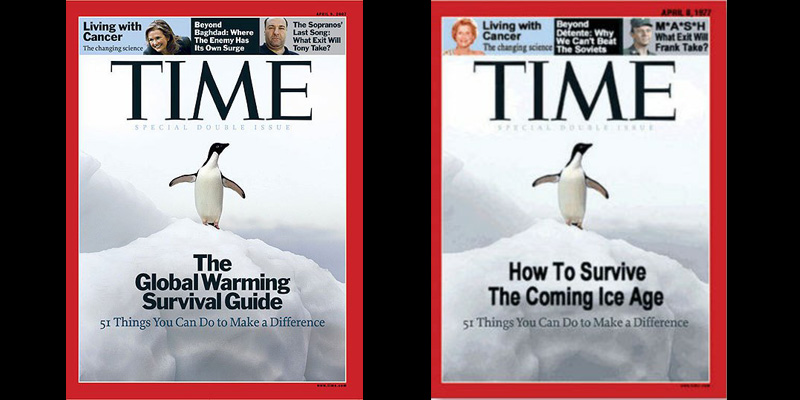It’s true that there was talk in the 1970s about a coming ice age. (Also, killer bees. Remember the killer bees?)

However, Time didn’t publish a cover story in 1977 with an appealing penguin, titled “How To Survive The Coming Ice Age.” That cover is a pretty dodgy Photoshop adaptation of a 2007 issue. (Time compares real and fake here.)
The fake cover, with a real one from 2006 warning about global warming are used by climate change skeptics to show that there was talk of global cooling in the 1970s and talk of global warming now, so global warming is not a thing. (This doesn’t make a whole lot of sense, I recognize.)
READ: Beware reports based on screenshotted tweets — here’s why (again)
The hoax made a surprise appearance at the White House, Politico reported this week, when an adviser briefing Donald Trump showed him the fake 1977 cover with the real 2006 cover, presenting it as an example of media hypocrisy.
Politico’s White House sources said that Trump reacts in an unfiltered way to news clippings that are put in front of him: “A news story tucked into Trump’s hands at the right moment can torpedo an appointment or redirect the president’s entire agenda. Current and former Trump officials say Trump can react volcanically to negative press clips, especially those with damaging leaks, becoming engrossed in finding out where they originated.”
READ: How sketchy Twitter rumours led to reports of Prince Philip’s death
Speaking to Politico, a White House official defended the fabrication as “fake but accurate,” on the basis that there was concern in the 1970s about global cooling.
READ: Fake news: How ads for mainstream brands end up in the Web’s dark corners
In fake news news:
- Sleeping Giants, the digital activist group that alerts mainstream brands when their ads appear in sites like Breitbart (which they generally don’t know about) now has a Canadian arm, @slpng_giants_ca. Its target: sites that advertise on The Rebel:
- Time has a long feature on the depth and sophistication of Russia’s social media offensive against the United States, and the West more generally: “Marrying a hundred years of expertise in influence operations to the new world of social media, Russia may finally have gained the ability it long sought but never fully achieved in the Cold War: to alter the course of events in the U.S. by manipulating public opinion.”
- Former Estonian president Toomas Hendrik Ilves (who you should follow on Twitter if you don’t already) warns of the West’s vulnerability to “digital aggression,” and argues that the West needs new forms of collective defence to counter it. “We see our own societies under threat from fake news, by antidemocratic, often racist rhetoric that drowns out the voices of reason,” he says.
- Facebook’s effort to deal with the spread of fake news on its networks has had a rocky start, the Guardian reports: debunked articles aren’t labelled, stories are labelled long after they’ve gone viral, and in some cases, labelling a story as fake makes it go viral.
- Microsoft warns that the recent WannaCry cyber attack (also known as WannaCrypt) “represents a completely unintended but disconcerting link between the two most serious forms of cybersecurity threats in the world today – nation-state action and organized criminal action.”
- The circle around Donald Trump is deeply entwined with the alt-right media world. A few outlets, like Breitbart and InfoWars, were given White House press credentials after Trump took office. Buzzfeed looks at the logical outcome of that – conservative blogger Mike Cernovich has now had a series of White House scoops due to his sources in the administration.


Comments